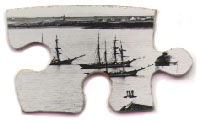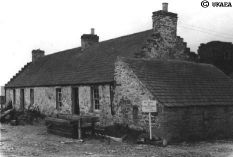



Highland Archives
Sponsored by ![]()
Man from the Ministry who paved the way for Dounreay
Stephen Cashmore turns back the pages of Caithness history more than 40 years to describe the land deals at Isauld and Lower Dounreay that enabled the county's atomic era to get under way in earnest. This is the first in a short series based on the personal papers of the late Donald Carmichael, the first administrative officer at the AEA's Dounreay site.
DONALD Carmichael was the Atomic Energy Authority's first permanent employee at the Dounreay site. Brought up in the manse at Reay only two miles away from Dounreay, Donald Carmichael was seconded to the AEA from an administrative post with the Ministry of Works. An Edinburgh University philosophy graduate who went on to lecture in the subject prior to going to Cambridge as a Carnegie scholar and fellow,he returned to Caithness at the start of the 1939-45 war to take charge of shore radar stations in the Far North. As an educated administrator with experience of personnel management and finance, possessing an intimate knowledge both of the complexities of the civil service and, as a local man, the internal affairs of Caithness, Carmichael was clearly a godsend to the AEA.
Donald Carmichael's personal correspondence relating to his early days at Dounreay is an archive filled with interesting sidelights on the establishment's early history. It does not, however, contain anything that would reinforce the opinions of those searching for hard evidence of conspiracies or hidden agendas. I am grateful to Donald Carmichael's widow for allowing me the opportunity to study his papers.
 |
| One of the farm steadings beside Dounreay Castle |
ON January 12, 1956, a Vauxhall Velox car, registration SK 4369, driven by Douglas Murray of Reay, sped past Pennyland Farm. Ignoring the road leading down to the harbour at Scrabster, the car;headed west in the direction of Melvich. There were two passengers in the back of this car. William Robertson, a chartered surveyor from Edinburgh, and Donald Carmichael, Administrative Officer with the recently-formed Atomic Energy Authority Industrial Group, whose leader, Christopher Hinton, a formidable engineer, had a pressing interest in the outcome of the Velox's journey. The weather forecast that morning had been bad to say the least -- heavy snow, possibly drifting in blizzard conditions. But the two officials had more on their minds than the weather; they were heading for two small farms about nine miles from Thurso.
The farms of Isauld and Lower Dounreay bordered an airfield owned by the Admiralty. Built in 1941 on land commandeered from Lower Dounreay, this airfield had been on a care-and-maintenance regime until 1954, when, with the announcement that it was the chosen site for Britain's experimental fast breeder reactor, it became the focus of worldwide attention. During the early 1950s the practical application of nuclear fission was at the forefront of engineering technology; nothing, it seemed, was to be allowed to stand in the way of advances in this exciting new field of science. Planning procedures, land acquisition, skilled staff transfer and recruitment, all these things were subjected to a fast-track approach, untypical of the slow, plodding progress commonly associated with the civil service. Already there were extensive nuclear facilities throughout England; Windscale, Risley, Harwell, Aldermaston, Springfields, Capenhurst, all had major installations employing thousands of highly-qualified staff. Dounreay was next on the list.
A construction timetable for the Dounreay plant had already been laid down. However, there was one slight snag -- the Government did not own the land necessary on which to build its fast breeder reactor. A narrow strip between the airfield and the shore had been earmarked as the site for the shaft, which had to be blasted through the rock as a preliminary stage in the construction of a sub-sea tunnel, designed to carry mildly radioactive effluent out into the sea. The farmhouse and steading of Lower Dounreay were situated on this strip of land; clearly it was in everyone's interest that they be vacated at the earliest opportunity. May 1, 1955, was the date the AEA wanted work on the shaft to commence. The owner of Isauld had different priorities, however.
A young farmer called Morris Pottinger had bought Lower Dounreay in November 1953. Neighbouring Isauld, the first port of call for William Robertson and his companion, was owned by Mrs Macdonald, who had agreed to sell her farm to the AEA and had given Donald Carmichael a verbal promise that she would quit Isauld in September. This would set in motion the next stage of a plan which would see Morris Pottinger and his wife Nettie moved out of Lower Dounreay farmhouse and into Isauld, which had then become the farmhouse for the combined holding with Morris as the AEA's tenant. But the best laid plans . . .
At Isauld, Mrs Macdonald was unwell with a heavy cold. She was also inclined to think that her promised September move was not a wise one, and May 1956 now suited her better. Mrs Macdonald was also concerned about the hill grazing tenancy she had for her sheep at Broubster. it was plain that Donald Carmichael and the chartered surveyor had some hard persuading to do before they returned to Thurso.
William Robertson made the first move, increasing his valuation of Isauld by 10 per cent providing that the farm was in the AEA's possession by November 28 at the very latest, the lady herself being rehoused in a brand new home even then being designed by Hugh Macdonald, the Thurso architect. Furthermore, the incoming tenant would be requested to take over all crops, stocks and implements at valuation, and two years' winter harbourage would be provided for Mrs Macdonald's sheep, in the unlikely event of her being unable to terminate her tenancy at Broubster on May 28, as she hoped to do. But the valuer's efforts fell on stony ground; the lady would.not move until May 1956, and that was that. Negotiations appeared to have reached a deadlock.
But a deadlock could not possibly be allowed. Christopher Hinton's instructions had been specific and virtually cast in letters of iron The purchase of Isauld farm and an agreed combined tenancy of that farm and Lower Dounreay was an absolute priority for the fast reactor project; Donald Carmichael knew it, just as he knew that the solving of problems like the one he now found facing him was one of the reasons he had been hired by the AEA. He was, after all, the man with the local knowledge.
As a Government agency, the AEA was duty-bound to abide by the decision of the valuer when it came to property purchase. There was no open cheque policy. True, powers of compulsory purchase were available, but, mindful off its public relations responsibilities, the AEA was extremely reluctant to invoke these powers. A little flexibility, a little creative valuation was required to solve the present problem. Carmichael took Robertson to one side for a quiet word.
A little later Donald Carmichael ,emerged :from a private conversation with Mrs Macdonald to announce that stage one of his task had been satisfactorily concluded; the purchase price for Isauld had increased by another five per cent, and the farm would be in the AEA's hands in September. It was time to meet with Morris Pottinger.
Noon had come and gone, the forecast snow was fast falling. In a rising blizzard Morris Pottinger arrived by tractor at Isauld to begin negotiations with Messrs Robertson and Carmichael. First they inspected the Isauld steading, swiftly reaching a broad consensus on the best methods of extending it to meet the extra needs of two farms once they were combined. Then, car closely following tractor, the men travelled the short distance to Lower Dounreay where they drew up sketch plans for the extended Isauld steading, and agreed in principle the modernisations necessary to fit Isauld House to the needs of a young family. The price the AEA was to pay for Lower Dounreay was settled, as was the rent Morris would pay for his combined tenancy of the two farms. It was time to return to Thurso.
By now the landscape around Dounreay was submerged beneath a thick layer of fresh snow. It was a forbidding prospect. The officials left the farmhouse, their car following hard on the heels of Morris Pottinger's tractor. If they could reach the main road... It was hopeless. Half-way up the farm road the car stuck fast and refused to move. There was nothing for it but to return to Lower Dounreay and hope for an improvement in the weather.
Two days came and went with the Thurso road still impassable. At Lower Dounreay the two officials fretted the long, inactive hours away - William Robertson, no doubt, thinking of his cosy Edinburgh office, his home comforts, all so different to the desolate scene outside Lower Dounreay. If Donald Carmichael, more familiar,with the vagaries of Far North weather, probably accepted his present situation more philosophically than his companion; but he, no doubt, would have been conscious of the urgency of his mission. The spectre of Christopher Hinton's powerful personality was probably never far from Carmichael's thoughts
In those days, when the roads were choked with snow, the village of Reay was supplied with essential provisions by sea, courtesy of the Thurso lifeboat. And so it happened that, on the morning of January 15, a tractor left Lower Dounreay en route to Sandside Harbour. On this tractor were two men - the driver, Morris Pottinger, and William Robertson, chartered surveyor, who rode spreadeagled on the back of the machine, near frozen to death in the icy wind. At Sandside they met up with Donald Carmichael, who had gone on ahead to arrange a passage back to Thurso with Angie Macintosh, the lifeboat coxswain. Once aboard the lifeboat, a long, rolling sea and a west wind carried the two officials to Scrabster, just in time for Mr Robertson to catch the afternoon train to Inverness. No doubt his wintertime escapade in Caithness remained hard etched in his memory.
Having seen his colleague off on the train, Donald Carmichael returned to his semi-permanent, seven guineas-a-week residence in Thurso's Royal Hotel, to plan the next step in his task of the AEA's "Mr Fixit". This step involved a trip to the industrial Group's Risley HQ. That night, before going to bed, Carmichael wrote the brief account of his recent experiences at Dounreay of which this article is a suitably embroidered expansion.
Since joining the AEA in September 1954, Donald Carmichael had noticed the pace of his life increasing week by week. Further details of his first year at Dounreay, drawn from his personal correspondence, will appear in future issues of this paper.
The sequel to the events of January 1955 a smidgen different to what had been agreed out at Dounreay on that snow-swept day. Mrs Macdonald did indeed get to stay on at Isauld House until May of '56, when her house was finally ready for her; Morris and Nettie continued to stay in the lower Dounreay farmhouse until Mrs Macdonald's new home was ready; and the AEA went ahead as planned with blasting out the shaft for its effluent tunnel.
The above article was based largely on documents from the personal archive of Donald Carmichael, Dounreay's first permanent employee. I am grateful to Margaret Carmichael for giving me the opportunity of consulting her late husband's papers.
Steven Cashmore 1998
![]()
Information contained on this page may only be used for
personal use,any request for full or part publication must be
carried out through the Highland archive.
Send information for these archives to william@caithnessarchives.org.uk